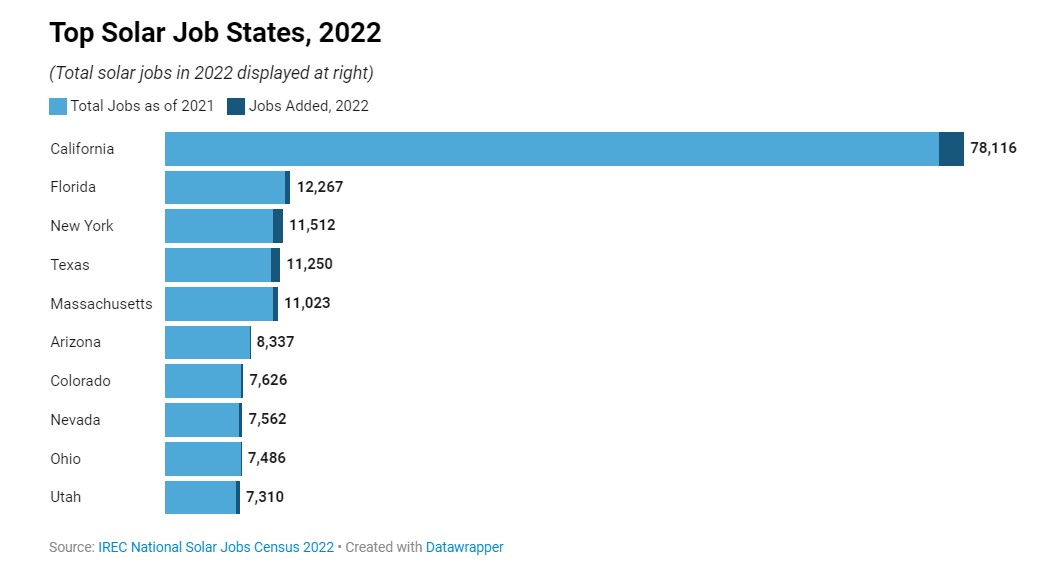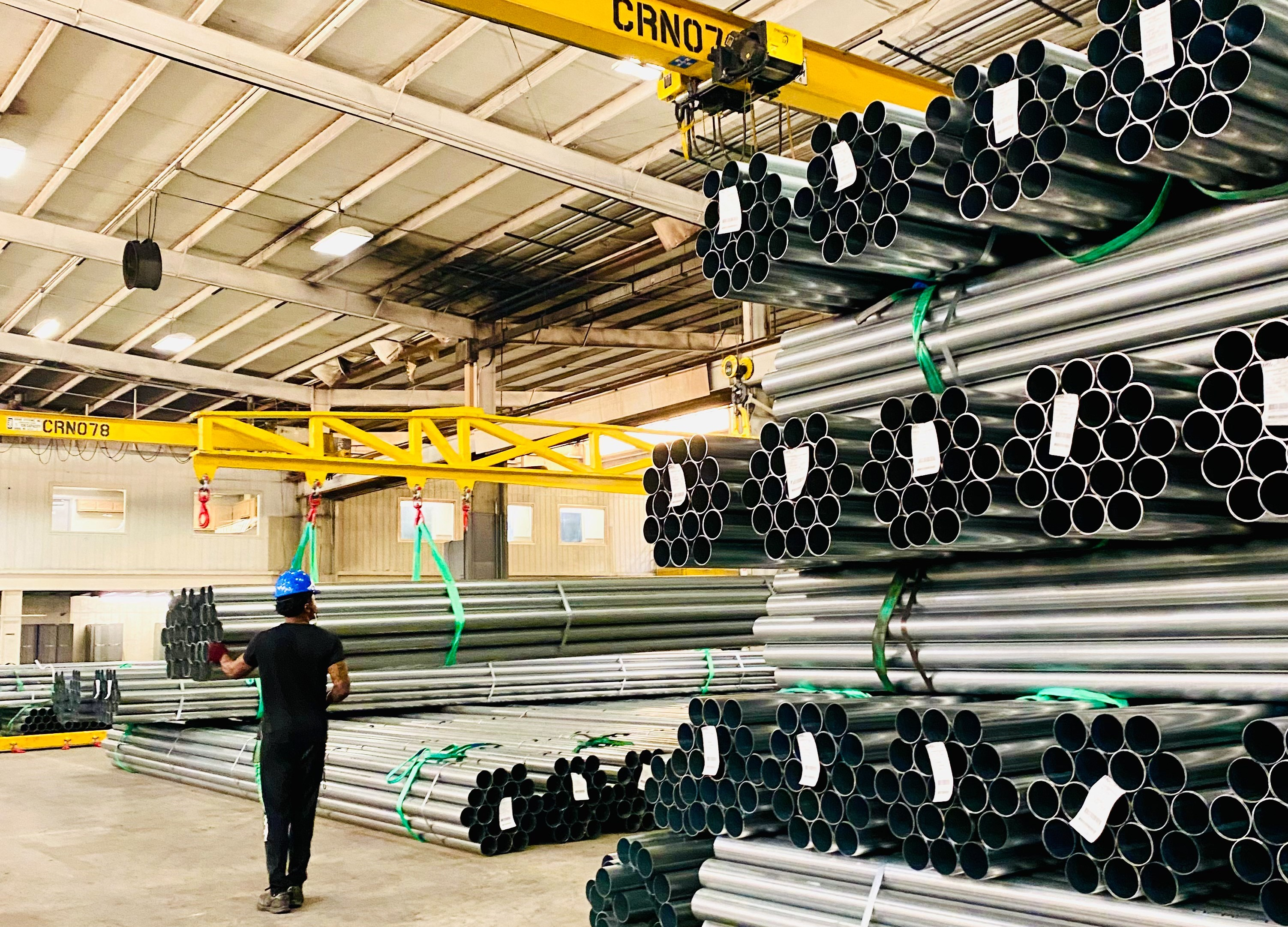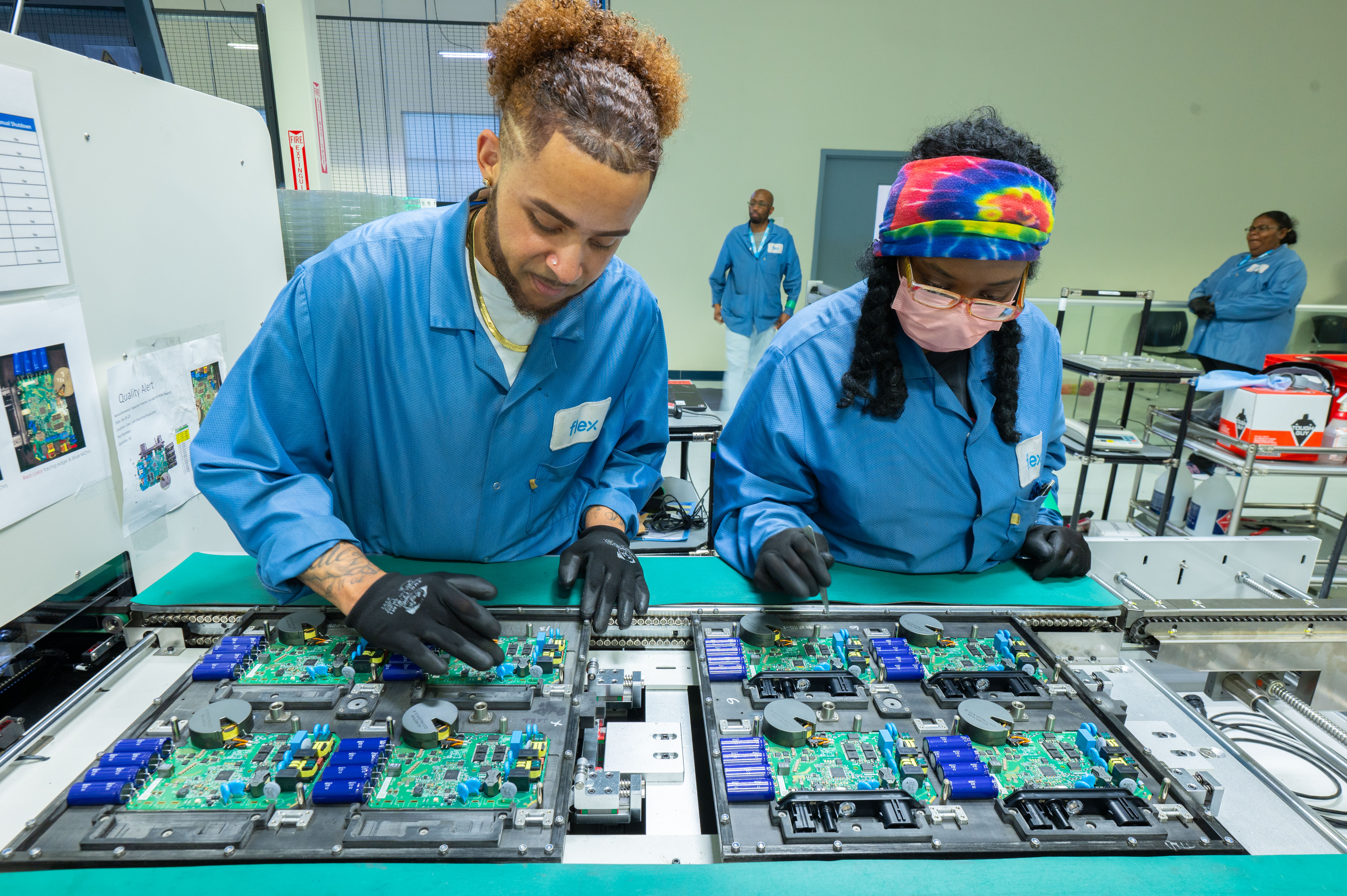A number of new reports shed light on where clean energy projects and jobs
are landing. The scope of one ongoing database in particular goes well
beyond solar and wind farm installation and operation.
In July the Interstate Renewable Energy Council (IREC) released its latest
National Solar Jobs Census. Key
findings included:
- The nation adding 8,846 solar jobs from 2021 to 2022 for a national
tally of 263,883 solar workers. About two-thirds of solar jobs (171,558)
are at installation and project development firms. Others are in
manufacturing (33,400), wholesale trade and distribution, and operations
and maintenance.
- “The utility-scale solar market lost about 6,000 jobs in 2022, as
policy challenges delayed large-scale installations. In contrast,
residential solar jobs grew by 11%, or about 9,500 jobs.”
- Forty-four percent of solar industry employers said it was “very
difficult” to find qualified applicants — the highest such percentage
ever recorded.
- Solar jobs grew in 42 states and Puerto Rico in 2022, with California
adding the most with 2,404 jobs added. New York, Texas, Florida, and
Massachusetts fill out the top five states in that order. “California
also added the most new solar capacity in 2022 (5.1 GW), followed by
Texas (3.6 GW) and Florida (1.9 GW),” IREC reports. “Texas not only led
the nation in utility-scale solar growth but also saw its best year ever
for residential solar.” States with high growth rates since 2017 include
Illinois (58%), Florida (43%), Virginia (33%), New York (28%), Texas
(27%), and Georgia (25%).
- “Overall, there were 546,630 workers in renewable energy generation
industries including solar, wind, traditional and low-impact
hydropower.”
Among the reasons cited by the IREC report for the 2022 slowdown was the
March 2022 U.S. Department of Commerce circumvention inquiry into solar
cells and modules imported from Cambodia, Malaysia, Thailand, and Vietnam.
A 24-month moratorium on any tariffs was declared by President Biden in
June 2022 as part of the inquiry, which should produce a final decision
this month. The Uyghur Forced Labor Prevention Act, enacted in 2021 to
prevent the importation of goods made by forced labor in China’s Xinjiang
Uyghur Autonomous Region, “led to hundreds of equipment detainments that
reduced the supply of modules by 18%, further constraining the
utility-scale sector,” IREC reports.
By contrast, the passage of the Inflation Reduction Act (IRA) is driving
growth today. “The National Renewable Energy Laboratory predicts that clean
electricity (including nuclear power) could grow from 41% of total
generation to 71-90% by 2030, mainly as a result of this new law,” IREC
says, which extends the Investment Tax Credit (ITC) for the next 10 years;
gives solar companies the option to use the Production Tax Credit; extends
the residential Investment Tax Credit for 10 years; includes an advanced
manufacturing tax credit for the domestic production of solar components;
and sets up a $27 billion greenhouse gas reduction fund to finance clean
energy projects. Solar firms anticipate 9% employment growth.
 |
“While much remains uncertain, the solar industry expects total U.S.
installations will multiply fivefold in the next 10 years, from 141 GW in
2022 to over 700 GW in 2033,” IREC reports. “The Solar Energy Industries
Association [SEIA} predicts the total number of solar jobs could more than
double, reaching 538,000 by 2032.”
Click here to access the SEIA’s
ongoing inventory of major solar projects, which shows more than 105 GW of
large-scale solar projects under construction or in development.
Cleaner & Greener By the Day
A report released this week by the American Clean Power Association (ACP)
provides project data to buttress the optimism. ACP says its “Investing in America: The Clean Energy Landscape
Today” report finds that “unprecedented federal support has led to
the announcement of private investments totaling $271 billion in domestic
clean energy projects and manufacturing facilities over the past 12 months.
This exceeds the combined clean energy investments made over the previous
eight years.”
Highlights from the report include public announcements from the past year
of:
- 184,850 MW of new utility-scale clean energy capacity
- 29,780 new manufacturing jobs
- Over $22 billion in manufacturing investment
- 83 new or expanded utility-scale clean energy manufacturing facilities.
“Manufacturing facilities for utility-scale clean energy components have
been announced in districts across the country,” ACP states, “and multiple
states have announced five or more facilities, including Georgia (7),
Tennessee (6), South Carolina (6), Texas (5), and Colorado (5).”
“Investment in clean energy production and manufacturing is surging. New
jobs and revenue are bringing opportunity and optimism to rural communities
across the country. America’s manufacturing centers are competing to meet
new clean energy demand with a new domestic wind, solar or storage
manufacturing facility announced every four days,” said ACP CEO Jason
Grumet. “The United States has the technology, human capital, and financial
capacity to achieve clean energy dominance. The only question is whether
government policy will allow us to build the clean energy infrastructure in
time to seize this opportunity.”
That means federal permitting reforms that shorten the five to 10 years it
can sometimes take to permit a clean energy facility. “It is also
imperative that Congress find common ground on transmission policy to
ensure that cheap, abundant clean energy can find its way to consumers,”
says ACP.
Should currently announced manufacturing facilities reach operation, ACP
estimates a nearly ninefold increase in solar module production and a more
than fifteenfold increase in grid-scale battery storage, along with
significant increases in production output for solar cells, polysilicon,
ingots and wafers, blades, towers and nacelles.
What’s Next for Nextracker?
One model company for the resurgence is Fremont, California–based solar
tracker manufacturer Nextracker. Yesterday the company joined electronics
component manufacturer Asteelflash/USI to announce the grand opening of
Asteelflash’s U.S. manufacturing line for Nextracker in its 197,000-sq.-ft.
facility in Fremont, California.
Nextracker says it has opened over 10 new U.S. production facilities in the
past year with its suppliers. In 2022, the company publicly inaugurated
four new steel fabrication lines in Texas, Arizona, Pennsylvania,
and Illinois.
As reported in the September 2022
issue of Site Selection, the company also knows how to renew old
industrial properties, as it joined with BCI Steel, a Pittsburgh-based
steel fabricator, to announce the reopening of the historic Bethlehem Steel
manufacturing factory in nearby Leetsdale to produce solar tracker
equipment for large-scale solar power plants.
“BCI Steel’s Pittsburgh factory enables the quick-ship response times we
need to meet booming demand from our customers in the Mid-Atlantic and
Heartland regions,” said Dan Shugar, CEO and Founder of Nextracker. “This
investment will increase the resilience of the U.S. solar supply chain and
bring manufacturing jobs, equipment, and capacity back to America.”
In May, Nextracker announced another
steel tracker factory in Memphis, Tennessee, that will receive millions of
dollars of investment and create 129 new jobs.
“We chose Memphis for our first U.S. plant to support Nextracker’s
utility-scale solar demand across the Southeast,” said António Pedro
Antunes, CEO of Metalogalva Group. “Memphis has the transportation,
infrastructure, and capable workforce necessary to support a solar
manufacturing program like this.”
 |
|
Nextracker and MSS Steel Tubes USA, a joint venture of
Metalogalva and Soufer, in May announced the commissioning of a
new 129-job factory in Memphis, Tennessee, to manufacture
low-carbon steel components for Nextracker’s solar tracking
systems.
|
|
Photo courtesy of Nextracker
|
The tube mill will feed projects in Kentucky, South Carolina, Virginia,
Mississippi, and Georgia. Tennessee-based Silicon Ranch is developing many
of those projects, having signed a supply agreement for 1.5 gigawatts with
Nextracker last year, and another new 3 gigawatt supply agreement at the
announcement in May.
“Nextracker’s new Tennessee tube mill not only helps us maintain our 100%
track record for successful project delivery but also enables us to support
additional investments in American manufacturing while lowering carbon
production processes of our supply chain, and reducing volatility and
logistics risks, all from our home state,” said Reagan Farr, Silicon Ranch
Co-Founder and CEO.
Microinverter-based solar and battery systems supplier Enphase Energy —
like Nextracker, also based in Fremont, California — in July announced
initial shipments of Enphase products produced in Columbia, South Carolina,
by global diversified manufacturer Flex. It marks the first production from
one of Enphase Energy’s three contract manufacturing partnerships in the
United States, driven in part, says the company, by the Inflation Reduction
Act
“Enphase shares our commitment to accelerating the world’s transition to
clean energy through advanced technology and strategic regional
manufacturing,” said Revathi Advaithi, CEO of Flex. “We thank Enphase for
their 15-year partnership to deliver their IQ Microinverters to market
faster and at scale globally with reliable, sustainable business practices.
We also thank President Biden and the U.S. Congress for the Inflation
Reduction Act, which has increased interest and demand for clean technology
and American manufacturing, as evidenced by today’s announcement with
Enphase.”
 |
|
Columbia, South Carolina–based Flex began shipping
microinverters in July as part of a 15-year agreement with
California-based Enphase Energy.
|
|
Photo courtesy of Flex
|
|